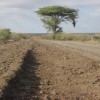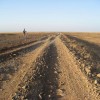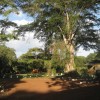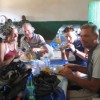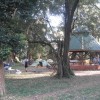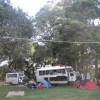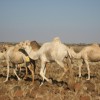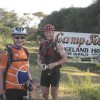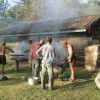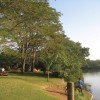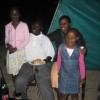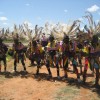KENYA travel report (1): day 49 to 52
- Created on Monday, 05 March 2007 13:44
- Written by Jan Eisenloeffel
Kenya became an independent country on December 12th, 1963. At some 583.000km2 which includes around 13.600km2 water of Lake Victoria, Kenya is comparable in size to France. The country has 35 million inhabitants. The highlands of Kenya are bisected by the Great Rift Valley, a fertile plateau in the west, and comprise one of the most successful agricultural production regions of Africa. The highlands are the site of the highest point in Kenya and second highest in Africa, Mount Kenya which reaches 5199m and is also the site of glaciers. Kenya has a tropical rain climate, influenced by the Indian Ocean and the close proximity to the equator. During the dry season (October-March) there is not much too see but some tufts of yellow grass. As soon as the rainy season starts (April-September) there is an explosion of colour all around.
Fauna and flora are very varied, there are more than 80 wild animal species, and over a thousand different birds. The "Big Five" animals can also be found in Kenya: lion. leopard, buffalo, rhino and elephant.
The most important source of income is the export of tea and coffee, next to it tourism to national parks and wild reserves. However, the economic growth has been falling for many years and domestic conflicts have damaged the tourist industry.
Thursday March 1, border-crossing between Ethiopia and Kenya. First, you visit three small offices on the Ethiopian side of the barrier, where they write down all sorts of things about your passport in a big book, and give you your exit stamp. This is very important because if you don't have the stamp and you go to Kenya on the other side, you won't get your visa and have to go back to Ethiopia. There they won't give you your exit stamp anymore because you just came in from Kenya. A real "catch 22" situation. With our exit stamp in hand we cross the border to Kenya. Here you fill in a form and card, pay US$ 50 and you have your visa to Kenya.
Mar.2 Our first day in Kenya was still an easy and fast ride over relatively good dirt roads and descending a good 400m from start to finish in Sololo. On the way there were a lot of monkeys, but it is hard to get a picture of them because as soon as you stop they scurry off and leave the trees they are sitting in. You also see many parrot-like birds sitting on branches of bush-like thorny trees that are prevalent here. The surroundings are desert dry but grown over with trees and bushes up to say 3-5m high fairly spaced so you could walk between them. You have to watch for thorns though as they are long and sharp, and easily penetrate the rubber sole of your shoe. Off course your cycle tires are a nice target too with many flats as a result. I have been lucky with only one flat so far, but then I check my tires for thorns regularly so they can't work there way in.
Mar.3-4 The tough stuff has started. Unbelievable rocky and stony roads or better tracks made by cars and trucks. However, they also throw up, for a bicycle, a big rim between the tracks that you need to jump when you have to change tracks. On Saturday I still managed to maintain the speed needed to do this without falling.
Sunday however, there was a gale blowing from the left and against us lowering the speed considerably and consequently I fell frequently. Luckily without serious consequences for me, but some of the riders had bad scrapes. We had to cycle through 60km of this with the second 30km also going up 300m to the Marsabit Park. Just as I was running out of water at 32km a small village appeared trough the dust storm where I could buy two bottles of water and a coke. Lunch was at 40k instead of the planned 50k due to the conditions and Jack (the tour leader) came back from the 79k extra drink stop to about 60k to replenish our water supply and with extra energy bars. Next we climbed to the Marsabit Park boundary and, thank heaven, the road surface improved considerably and the wind became less, from here to the finish at 85km in the town of Marsabit. Needless to say that I arrived like everybody else quite pooped at the finish, but after a few cokes, bitterlemons and a fruit salad this soon changed for the better. The Marsabit Park, 360km2, lies within the Marsabit National Reserve, 1222km2. The park itself is around a dormant volcano responsible for the miserable lava rock we had to cycle through, and is quite wildly beautiful with an elevation of 1300m. It is the habitat of huge male elephants with their enormous tasks.
Mar.5 Today, day 52, a rest day. We camp on the terrain of the Kenya Wildlife Service. A very nice camp under huge shady trees with centuries old Yellowwood trees among them. Colonies of baboons live in these old trees. Last night they must have been disturbed by something (us campers perhaps?) because they made an unbelievable racket a few times waking everybody. Moreover they pee like a waterfall and poo with plopping sounds from the branches they are sitting on completely disregarding the tents below. Just guess the consequences for the riders who had found a beautiful shady spot right under this massive tree. Those tents are hanging out to dry right now. Although I pitched my tent and slept in it I also have a room in the hotel in town together with Chris (only $3,00 pp for two nights) so we can use the hotel facilities to shower, wash, shave, have breakfast, dinner etc., quite handy. In the next 6 days we will ride to Nairobi, 3 days of good dirt roads to Isiolo, then we will hit the tarmac again until we get to Nairobi, and there will be a fair amount of climbing around Mount Kenya.
Fauna and flora are very varied, there are more than 80 wild animal species, and over a thousand different birds. The "Big Five" animals can also be found in Kenya: lion. leopard, buffalo, rhino and elephant.
The most important source of income is the export of tea and coffee, next to it tourism to national parks and wild reserves. However, the economic growth has been falling for many years and domestic conflicts have damaged the tourist industry.
Thursday March 1, border-crossing between Ethiopia and Kenya. First, you visit three small offices on the Ethiopian side of the barrier, where they write down all sorts of things about your passport in a big book, and give you your exit stamp. This is very important because if you don't have the stamp and you go to Kenya on the other side, you won't get your visa and have to go back to Ethiopia. There they won't give you your exit stamp anymore because you just came in from Kenya. A real "catch 22" situation. With our exit stamp in hand we cross the border to Kenya. Here you fill in a form and card, pay US$ 50 and you have your visa to Kenya.
Mar.2 Our first day in Kenya was still an easy and fast ride over relatively good dirt roads and descending a good 400m from start to finish in Sololo. On the way there were a lot of monkeys, but it is hard to get a picture of them because as soon as you stop they scurry off and leave the trees they are sitting in. You also see many parrot-like birds sitting on branches of bush-like thorny trees that are prevalent here. The surroundings are desert dry but grown over with trees and bushes up to say 3-5m high fairly spaced so you could walk between them. You have to watch for thorns though as they are long and sharp, and easily penetrate the rubber sole of your shoe. Off course your cycle tires are a nice target too with many flats as a result. I have been lucky with only one flat so far, but then I check my tires for thorns regularly so they can't work there way in.
Mar.3-4 The tough stuff has started. Unbelievable rocky and stony roads or better tracks made by cars and trucks. However, they also throw up, for a bicycle, a big rim between the tracks that you need to jump when you have to change tracks. On Saturday I still managed to maintain the speed needed to do this without falling.
Mar.5 Today, day 52, a rest day. We camp on the terrain of the Kenya Wildlife Service. A very nice camp under huge shady trees with centuries old Yellowwood trees among them. Colonies of baboons live in these old trees. Last night they must have been disturbed by something (us campers perhaps?) because they made an unbelievable racket a few times waking everybody. Moreover they pee like a waterfall and poo with plopping sounds from the branches they are sitting on completely disregarding the tents below. Just guess the consequences for the riders who had found a beautiful shady spot right under this massive tree. Those tents are hanging out to dry right now. Although I pitched my tent and slept in it I also have a room in the hotel in town together with Chris (only $3,00 pp for two nights) so we can use the hotel facilities to shower, wash, shave, have breakfast, dinner etc., quite handy. In the next 6 days we will ride to Nairobi, 3 days of good dirt roads to Isiolo, then we will hit the tarmac again until we get to Nairobi, and there will be a fair amount of climbing around Mount Kenya.
KENYA travel report (2): pointers for your african camping trip.
- Created on Thursday, 08 March 2007 13:46
- Written by Jan Eisenloeffel
!!!FLAT INFLATABLE MATTRESS!!!
Day 49 I get up after a literally "hard" night, my inflatable mattress is as flat as a pancake! Just when we are starting out on the section called "meltdown madness", what the **** happened? It quickly proves to be the tree on the terrain of the Kenya Wildlife Service under which I pitched my tent for shade. It is a thorny one and although I cleared the ground of thorny branches before setting up the tent I must have overlooked the smaller ones.
That afternoon in the Sololo bush camp I submerge the mattress under water and strings of little bubbles coming out of pinholes everywhere. I try to mark them but neither ballpoint, pencil or marker seem to leave a mark on the wetted surface. After some experimenting I find a way: blow up the mattress as hard as possible, wet the surface with your hand, while drying the "holy" spot also mark the hole with a ballpoint. I find and mark 14 pinholes concentrated in two groups, let the mattress dry well, then dab glue from the repair kit on each pinhole and let it dry (takes six hours for the stickiness to disappear). That night I sleep hard again, but the good news is that the mattress stays inflated longer. There is hope, but no time the next two days to find the other holes, those I repair during the rest day in Marsabit, 12 more holes in total, and they are indeed the last ones. My mattress holds its air at long last!
Africa camping lesson 1: never set up your tent under or around a thorny tree or bush if you use an inflatable sleeping mat!
!!!MONKEY BUSINESS!!!
Day 52 Our rest day in Marsabit. I arise after a double hard night. First my inflatable mattress still needs to be repaired (see above), secondly the Baboons had interrupted my sleep a zillion times with their screaming during the night. It all seemed to be good to be true when we arrived in Marsabit after an incredible hard riding day: the Kenyan Wildlife Service. The camp grounds are well maintained, nicely laid out, huge Yellowwood (thorn-less!) trees which provide the much coveted shade where to set up your tent, and to top it off such a nice family group of Baboons. A rather large "dad", many females, an oh so cute baby and young Baboons running around on the ground! They sleep and are quiet at night we are assured.
Night arrives, we sit around the camp have beers, wine, soft drinks and talk about the past day, apart from our racket wonderful quietness reins. Not too late we go to our tents, as this has been a hard tiresome day, for a wonderful well deserved rest. However, the monkeys apparently think differently. As soon as we are asleep we wake up because of a horrid screaming: the Baboons! The adults make first a woofing kind of warning sound because they are alarmed about something. The young ones get scared and start crying whereupon the adults to keep them quiet hit them after which the young ones really scream because it hurts! Then the adults yell at them to keep quiet. This goes on for a while, then they calm down and rest descends upon the camp until the next episode. Monkeys, just like people, have to go to the toilet too. We get up out of our tent, walk to the place where you do those things, do it, go back to your tent and back to sleep. Monkeys just stay where they are and let everything flow and drop down to the ground below. Come to think of it, if we slept in trees we would do the same! The consequences could have been foreseen had we known more about the day/night behavioural pattern of Baboons. OUR TENTS ARE THERE, damn you monkeys, can't you figure that out.
Africa camping lesson 2: never set up your tent under, better yet in the vicinity of, trees in which monkeys tend to spend their days and/or nights.
Day 49 I get up after a literally "hard" night, my inflatable mattress is as flat as a pancake! Just when we are starting out on the section called "meltdown madness", what the **** happened? It quickly proves to be the tree on the terrain of the Kenya Wildlife Service under which I pitched my tent for shade. It is a thorny one and although I cleared the ground of thorny branches before setting up the tent I must have overlooked the smaller ones.
That afternoon in the Sololo bush camp I submerge the mattress under water and strings of little bubbles coming out of pinholes everywhere. I try to mark them but neither ballpoint, pencil or marker seem to leave a mark on the wetted surface. After some experimenting I find a way: blow up the mattress as hard as possible, wet the surface with your hand, while drying the "holy" spot also mark the hole with a ballpoint. I find and mark 14 pinholes concentrated in two groups, let the mattress dry well, then dab glue from the repair kit on each pinhole and let it dry (takes six hours for the stickiness to disappear). That night I sleep hard again, but the good news is that the mattress stays inflated longer. There is hope, but no time the next two days to find the other holes, those I repair during the rest day in Marsabit, 12 more holes in total, and they are indeed the last ones. My mattress holds its air at long last!
Africa camping lesson 1: never set up your tent under or around a thorny tree or bush if you use an inflatable sleeping mat!
!!!MONKEY BUSINESS!!!
Day 52 Our rest day in Marsabit. I arise after a double hard night. First my inflatable mattress still needs to be repaired (see above), secondly the Baboons had interrupted my sleep a zillion times with their screaming during the night. It all seemed to be good to be true when we arrived in Marsabit after an incredible hard riding day: the Kenyan Wildlife Service. The camp grounds are well maintained, nicely laid out, huge Yellowwood (thorn-less!) trees which provide the much coveted shade where to set up your tent, and to top it off such a nice family group of Baboons. A rather large "dad", many females, an oh so cute baby and young Baboons running around on the ground! They sleep and are quiet at night we are assured.
Night arrives, we sit around the camp have beers, wine, soft drinks and talk about the past day, apart from our racket wonderful quietness reins. Not too late we go to our tents, as this has been a hard tiresome day, for a wonderful well deserved rest. However, the monkeys apparently think differently. As soon as we are asleep we wake up because of a horrid screaming: the Baboons! The adults make first a woofing kind of warning sound because they are alarmed about something. The young ones get scared and start crying whereupon the adults to keep them quiet hit them after which the young ones really scream because it hurts! Then the adults yell at them to keep quiet. This goes on for a while, then they calm down and rest descends upon the camp until the next episode. Monkeys, just like people, have to go to the toilet too. We get up out of our tent, walk to the place where you do those things, do it, go back to your tent and back to sleep. Monkeys just stay where they are and let everything flow and drop down to the ground below. Come to think of it, if we slept in trees we would do the same! The consequences could have been foreseen had we known more about the day/night behavioural pattern of Baboons. OUR TENTS ARE THERE, damn you monkeys, can't you figure that out.
Africa camping lesson 2: never set up your tent under, better yet in the vicinity of, trees in which monkeys tend to spend their days and/or nights.
KENYA travelreport (3): day 53 to 60
- Created on Wednesday, 14 March 2007 13:47
- Written by Jan Eisenloeffel
TdA report, day 53-61 Three days of non-cycling rest days in Tanzania! To earn these days we had to get here first and that is quite a story especially the ride through northern Kenya. In France the Paris-Roubaix cycle race is called "the hell of the north". As for as I am concerned the ride through the northern part of Kenya, from the border town Moyale to Isiolo where the asphalt starts, more than qualifies for this name. The roads were incredibly bad, at temperatures in the 40 Celsius, with a day of gale force side-winds and dust-storms thrown in for good measure, the only relief being the Marsabit Park where we had to climb to an elevation of 1370m. Only drawback here: scorpions!
Incredibly as it may seem but we regularly saw people in the fields. Most seem to be tending large herds of cattle, goats, sheep and camels, driving them to waterholes and grassy areas. In most cases they do not want to be photographed and get quite violent if you don't put your camera away. The women are very colourfully dressed and carry loads of ornaments around neck, chest, arms and ankles. During the occasional drink stops you make, you get crowded with women trying to sell ornaments to you, and the men just standing around looking at these strangers in their funny (cycling)clothes.
Mar.7 In Laisamis we had our bush camp in a wadi with a pump where the women come to fill up yellow plastic jerry-cans with water which they then have to carry home! Just a stone's throw away from our camp is a boarding school, and with the young adults who speak excellent English, I had a good discussions about their schooling and plans for the future. Refreshing to finally strike up a conversation with Kenyans.
Mar.8 When we arrived in Isiolo civilization started for us. In the town we could purchase things like yoghurt drinks and ICE CREAM! Camp was about 8km beyond Isiolo at the Rangeland Camping which had all the facilities you dreamt of: showers, toilets, wash basins to do your laundry, nice grass to pitch your tent, shady trees without monkeys and a bar with cold drinks. From here on to Nairobi we camped each night at similar facilities.
Mar.9 The ride from Isiolo to Nanyuki was a spectacular long climb up the flanks of Mt. Kenya with beautiful views of the high peaks and the surrounding rich landscape. Hills covered with sunflower and corn crops, and thatched cottages.
Mar.10-11 From Nanyuki, via Sagana, to Nairobi was a two day trip. Over reasonably good roads leading through banana plantations we arrived at an absolutely splendid camping spot on the Tana River, the White Water Camp. Grass everywhere, swimming pool, white water rafting, to name just a few. At night a barbecue with pork chops and a toga party to celebrate passing the equator. The Blue Post Hotel was the official start of our 45km convoy into Nairobi so there were bikes, trucks, bakkies and people lined up everywhere. Once the Kenyan tourist police arrived we began our slow journey towards Nairobi. Three hours later we entered the city, and also marked the end of the "meltdown madness" section.
Mar.12 In Nairobi we had a rest day, but I didn't get to see much of the city due to all the necessary chores that had to be done. Another reason was my right leg, the wounds (blame the horrible north) are not healing properly, my leg is slightly swollen, so I needed to rest with my leg up (nurse's orders!). We were invited for a very peasant dinner at the home of Douglas, our blind tandem rider I spoke of earlier. However, during the long ride into town and later out of town I did get a good impression of the city with its many slum, and to me messy, areas along side super modern buildings.
Nairobi is a completely modern creation and almost everything here has been built in the last 100 years. Until the 1890s the whole area was just an isolated swamp, but as the rails of the East-Africa railway fell into place, a depot was established on the edge of a small stream known to the Maasai as uaso nairobi (cold water).As East Africa's largest city and the region's main transport hub, Nairobi is situated firmly at the centre of national and political life.
Mar.13 Our last day in Kenya. With police escort we left the city and cycled to Namanga where again we camped at a super camp site. The ride there was uneventful, over times very rough asphalt and after lunch it became very hot with temperatures in the 40s. At lunch and later at the campsite we were surprised by a show of Kenyan folk dancers, arranged by the Nairobi office of the sponsor of Belgian rider Siegfried. A very colourful and dynamic dance show, surely an appropriate way to say goodbye to this country of contrasts, beauty and smiling people.
Mar.14 Today marked our farewell to Kenya, as we entered the fifth country of the tour - Tanzania. It was a non-race day, for all riders an opportunity to enjoy the first day of this country at their leisure. With paved roads, cooler temperatures and Kilimanjaro in the distance, who wouldn't?
Incredibly as it may seem but we regularly saw people in the fields. Most seem to be tending large herds of cattle, goats, sheep and camels, driving them to waterholes and grassy areas. In most cases they do not want to be photographed and get quite violent if you don't put your camera away. The women are very colourfully dressed and carry loads of ornaments around neck, chest, arms and ankles. During the occasional drink stops you make, you get crowded with women trying to sell ornaments to you, and the men just standing around looking at these strangers in their funny (cycling)clothes.
Mar.7 In Laisamis we had our bush camp in a wadi with a pump where the women come to fill up yellow plastic jerry-cans with water which they then have to carry home! Just a stone's throw away from our camp is a boarding school, and with the young adults who speak excellent English, I had a good discussions about their schooling and plans for the future. Refreshing to finally strike up a conversation with Kenyans.
Mar.9 The ride from Isiolo to Nanyuki was a spectacular long climb up the flanks of Mt. Kenya with beautiful views of the high peaks and the surrounding rich landscape. Hills covered with sunflower and corn crops, and thatched cottages.
Mar.10-11 From Nanyuki, via Sagana, to Nairobi was a two day trip. Over reasonably good roads leading through banana plantations we arrived at an absolutely splendid camping spot on the Tana River, the White Water Camp. Grass everywhere, swimming pool, white water rafting, to name just a few. At night a barbecue with pork chops and a toga party to celebrate passing the equator. The Blue Post Hotel was the official start of our 45km convoy into Nairobi so there were bikes, trucks, bakkies and people lined up everywhere. Once the Kenyan tourist police arrived we began our slow journey towards Nairobi. Three hours later we entered the city, and also marked the end of the "meltdown madness" section.
Mar.12 In Nairobi we had a rest day, but I didn't get to see much of the city due to all the necessary chores that had to be done. Another reason was my right leg, the wounds (blame the horrible north) are not healing properly, my leg is slightly swollen, so I needed to rest with my leg up (nurse's orders!). We were invited for a very peasant dinner at the home of Douglas, our blind tandem rider I spoke of earlier. However, during the long ride into town and later out of town I did get a good impression of the city with its many slum, and to me messy, areas along side super modern buildings.
Nairobi is a completely modern creation and almost everything here has been built in the last 100 years. Until the 1890s the whole area was just an isolated swamp, but as the rails of the East-Africa railway fell into place, a depot was established on the edge of a small stream known to the Maasai as uaso nairobi (cold water).As East Africa's largest city and the region's main transport hub, Nairobi is situated firmly at the centre of national and political life.
Mar.13 Our last day in Kenya. With police escort we left the city and cycled to Namanga where again we camped at a super camp site. The ride there was uneventful, over times very rough asphalt and after lunch it became very hot with temperatures in the 40s. At lunch and later at the campsite we were surprised by a show of Kenyan folk dancers, arranged by the Nairobi office of the sponsor of Belgian rider Siegfried. A very colourful and dynamic dance show, surely an appropriate way to say goodbye to this country of contrasts, beauty and smiling people.
Mar.14 Today marked our farewell to Kenya, as we entered the fifth country of the tour - Tanzania. It was a non-race day, for all riders an opportunity to enjoy the first day of this country at their leisure. With paved roads, cooler temperatures and Kilimanjaro in the distance, who wouldn't?

